Ebola Crisis: Overview, Assessment, Intervention, and Challenges
VerifiedAdded on 2023/04/07
|11
|2025
|147
Essay
AI Summary
This essay provides a comprehensive analysis of the Ebola crisis, beginning with an introduction to the disease and its impact on public health. It offers an overview of the crisis, focusing on the 2018 outbreak in the Democratic Republic of Congo, and discusses the criteria that define Ebola as a crisis, including its rapid spread and the uncertainty it creates. The essay explores the model of triage assessment used during outbreaks, emphasizing the importance of isolating suspected cases. It then details crisis intervention strategies, such as active case finding and contact tracing, while also addressing challenges like inadequate training and supply chain issues. The importance of crisis worker self-care is also highlighted. Overall, the essay emphasizes the need for effective strategies to mitigate the impact of Ebola and reduce mortality rates, concluding with references to relevant research and a crisis update from February 2019.
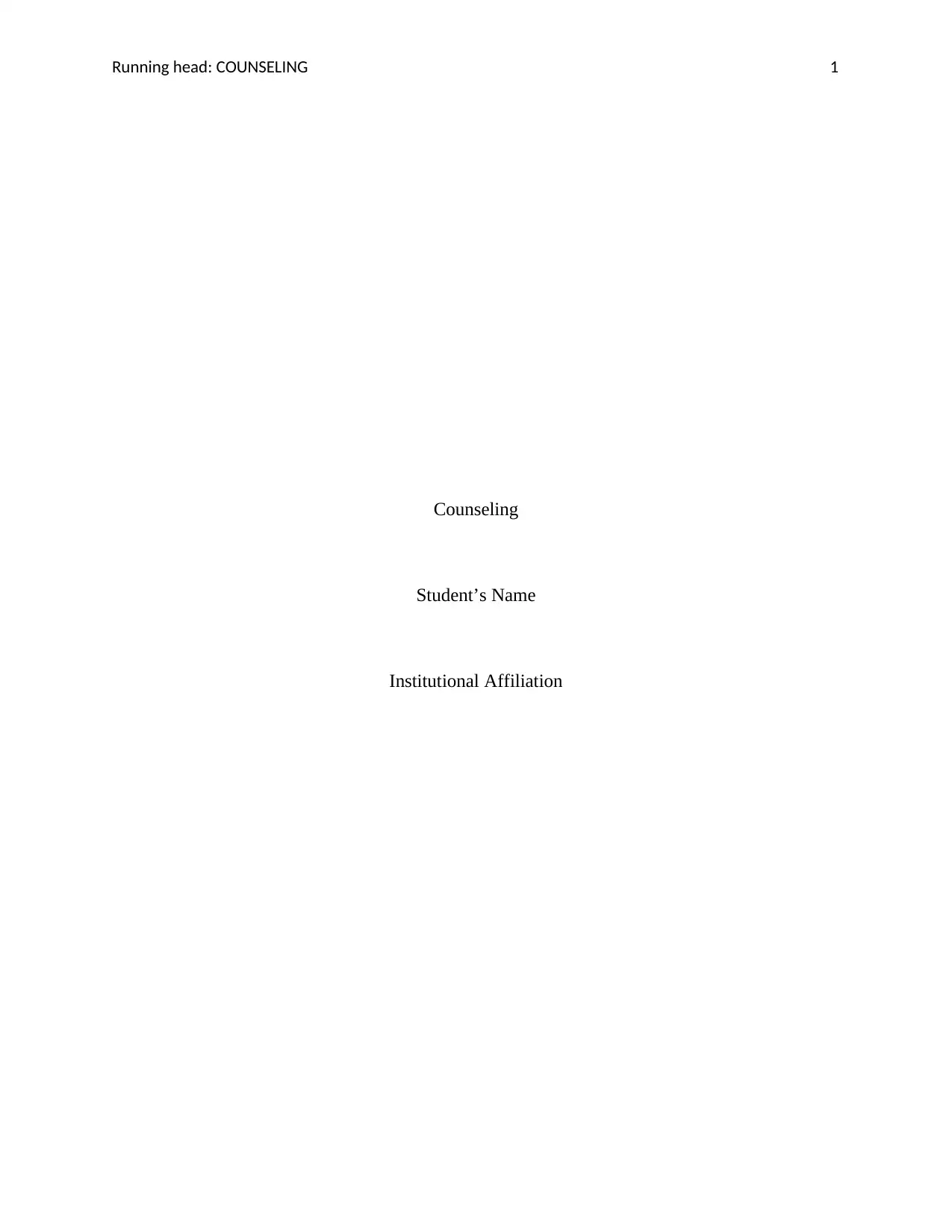
Running head: COUNSELING 1
Counseling
Student’s Name
Institutional Affiliation
Counseling
Student’s Name
Institutional Affiliation
Paraphrase This Document
Need a fresh take? Get an instant paraphrase of this document with our AI Paraphraser
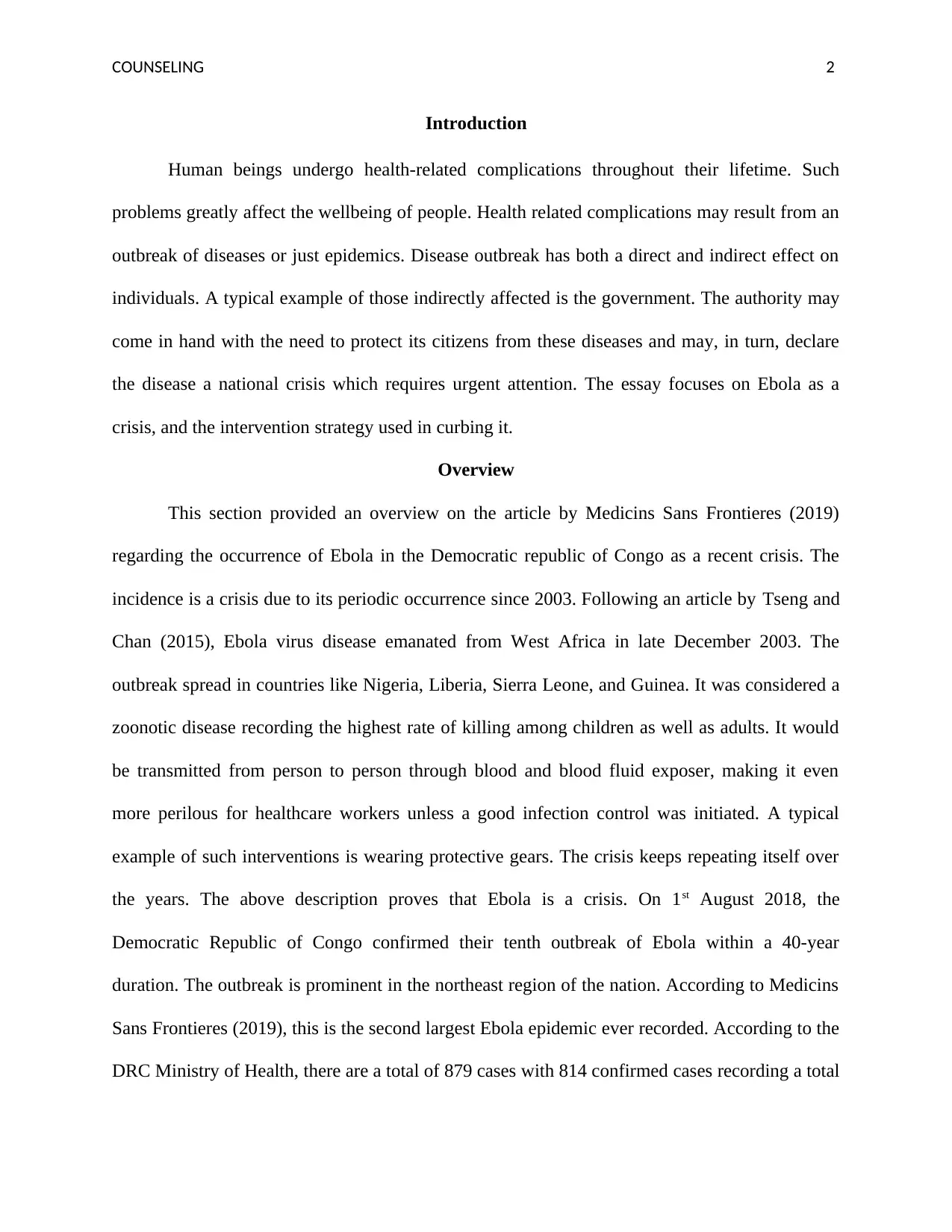
COUNSELING 2
Introduction
Human beings undergo health-related complications throughout their lifetime. Such
problems greatly affect the wellbeing of people. Health related complications may result from an
outbreak of diseases or just epidemics. Disease outbreak has both a direct and indirect effect on
individuals. A typical example of those indirectly affected is the government. The authority may
come in hand with the need to protect its citizens from these diseases and may, in turn, declare
the disease a national crisis which requires urgent attention. The essay focuses on Ebola as a
crisis, and the intervention strategy used in curbing it.
Overview
This section provided an overview on the article by Medicins Sans Frontieres (2019)
regarding the occurrence of Ebola in the Democratic republic of Congo as a recent crisis. The
incidence is a crisis due to its periodic occurrence since 2003. Following an article by Tseng and
Chan (2015), Ebola virus disease emanated from West Africa in late December 2003. The
outbreak spread in countries like Nigeria, Liberia, Sierra Leone, and Guinea. It was considered a
zoonotic disease recording the highest rate of killing among children as well as adults. It would
be transmitted from person to person through blood and blood fluid exposer, making it even
more perilous for healthcare workers unless a good infection control was initiated. A typical
example of such interventions is wearing protective gears. The crisis keeps repeating itself over
the years. The above description proves that Ebola is a crisis. On 1st August 2018, the
Democratic Republic of Congo confirmed their tenth outbreak of Ebola within a 40-year
duration. The outbreak is prominent in the northeast region of the nation. According to Medicins
Sans Frontieres (2019), this is the second largest Ebola epidemic ever recorded. According to the
DRC Ministry of Health, there are a total of 879 cases with 814 confirmed cases recording a total
Introduction
Human beings undergo health-related complications throughout their lifetime. Such
problems greatly affect the wellbeing of people. Health related complications may result from an
outbreak of diseases or just epidemics. Disease outbreak has both a direct and indirect effect on
individuals. A typical example of those indirectly affected is the government. The authority may
come in hand with the need to protect its citizens from these diseases and may, in turn, declare
the disease a national crisis which requires urgent attention. The essay focuses on Ebola as a
crisis, and the intervention strategy used in curbing it.
Overview
This section provided an overview on the article by Medicins Sans Frontieres (2019)
regarding the occurrence of Ebola in the Democratic republic of Congo as a recent crisis. The
incidence is a crisis due to its periodic occurrence since 2003. Following an article by Tseng and
Chan (2015), Ebola virus disease emanated from West Africa in late December 2003. The
outbreak spread in countries like Nigeria, Liberia, Sierra Leone, and Guinea. It was considered a
zoonotic disease recording the highest rate of killing among children as well as adults. It would
be transmitted from person to person through blood and blood fluid exposer, making it even
more perilous for healthcare workers unless a good infection control was initiated. A typical
example of such interventions is wearing protective gears. The crisis keeps repeating itself over
the years. The above description proves that Ebola is a crisis. On 1st August 2018, the
Democratic Republic of Congo confirmed their tenth outbreak of Ebola within a 40-year
duration. The outbreak is prominent in the northeast region of the nation. According to Medicins
Sans Frontieres (2019), this is the second largest Ebola epidemic ever recorded. According to the
DRC Ministry of Health, there are a total of 879 cases with 814 confirmed cases recording a total
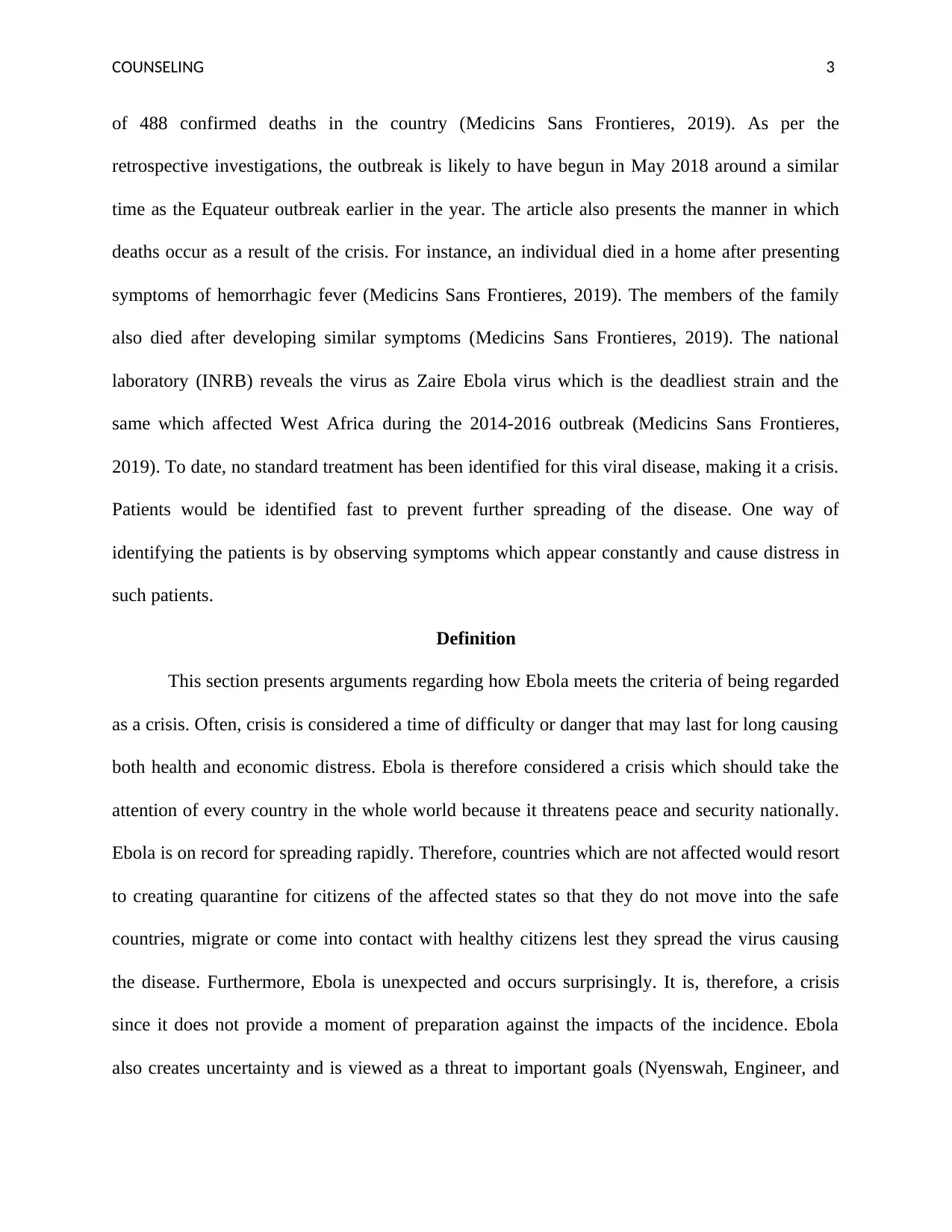
COUNSELING 3
of 488 confirmed deaths in the country (Medicins Sans Frontieres, 2019). As per the
retrospective investigations, the outbreak is likely to have begun in May 2018 around a similar
time as the Equateur outbreak earlier in the year. The article also presents the manner in which
deaths occur as a result of the crisis. For instance, an individual died in a home after presenting
symptoms of hemorrhagic fever (Medicins Sans Frontieres, 2019). The members of the family
also died after developing similar symptoms (Medicins Sans Frontieres, 2019). The national
laboratory (INRB) reveals the virus as Zaire Ebola virus which is the deadliest strain and the
same which affected West Africa during the 2014-2016 outbreak (Medicins Sans Frontieres,
2019). To date, no standard treatment has been identified for this viral disease, making it a crisis.
Patients would be identified fast to prevent further spreading of the disease. One way of
identifying the patients is by observing symptoms which appear constantly and cause distress in
such patients.
Definition
This section presents arguments regarding how Ebola meets the criteria of being regarded
as a crisis. Often, crisis is considered a time of difficulty or danger that may last for long causing
both health and economic distress. Ebola is therefore considered a crisis which should take the
attention of every country in the whole world because it threatens peace and security nationally.
Ebola is on record for spreading rapidly. Therefore, countries which are not affected would resort
to creating quarantine for citizens of the affected states so that they do not move into the safe
countries, migrate or come into contact with healthy citizens lest they spread the virus causing
the disease. Furthermore, Ebola is unexpected and occurs surprisingly. It is, therefore, a crisis
since it does not provide a moment of preparation against the impacts of the incidence. Ebola
also creates uncertainty and is viewed as a threat to important goals (Nyenswah, Engineer, and
of 488 confirmed deaths in the country (Medicins Sans Frontieres, 2019). As per the
retrospective investigations, the outbreak is likely to have begun in May 2018 around a similar
time as the Equateur outbreak earlier in the year. The article also presents the manner in which
deaths occur as a result of the crisis. For instance, an individual died in a home after presenting
symptoms of hemorrhagic fever (Medicins Sans Frontieres, 2019). The members of the family
also died after developing similar symptoms (Medicins Sans Frontieres, 2019). The national
laboratory (INRB) reveals the virus as Zaire Ebola virus which is the deadliest strain and the
same which affected West Africa during the 2014-2016 outbreak (Medicins Sans Frontieres,
2019). To date, no standard treatment has been identified for this viral disease, making it a crisis.
Patients would be identified fast to prevent further spreading of the disease. One way of
identifying the patients is by observing symptoms which appear constantly and cause distress in
such patients.
Definition
This section presents arguments regarding how Ebola meets the criteria of being regarded
as a crisis. Often, crisis is considered a time of difficulty or danger that may last for long causing
both health and economic distress. Ebola is therefore considered a crisis which should take the
attention of every country in the whole world because it threatens peace and security nationally.
Ebola is on record for spreading rapidly. Therefore, countries which are not affected would resort
to creating quarantine for citizens of the affected states so that they do not move into the safe
countries, migrate or come into contact with healthy citizens lest they spread the virus causing
the disease. Furthermore, Ebola is unexpected and occurs surprisingly. It is, therefore, a crisis
since it does not provide a moment of preparation against the impacts of the incidence. Ebola
also creates uncertainty and is viewed as a threat to important goals (Nyenswah, Engineer, and
⊘ This is a preview!⊘
Do you want full access?
Subscribe today to unlock all pages.

Trusted by 1+ million students worldwide
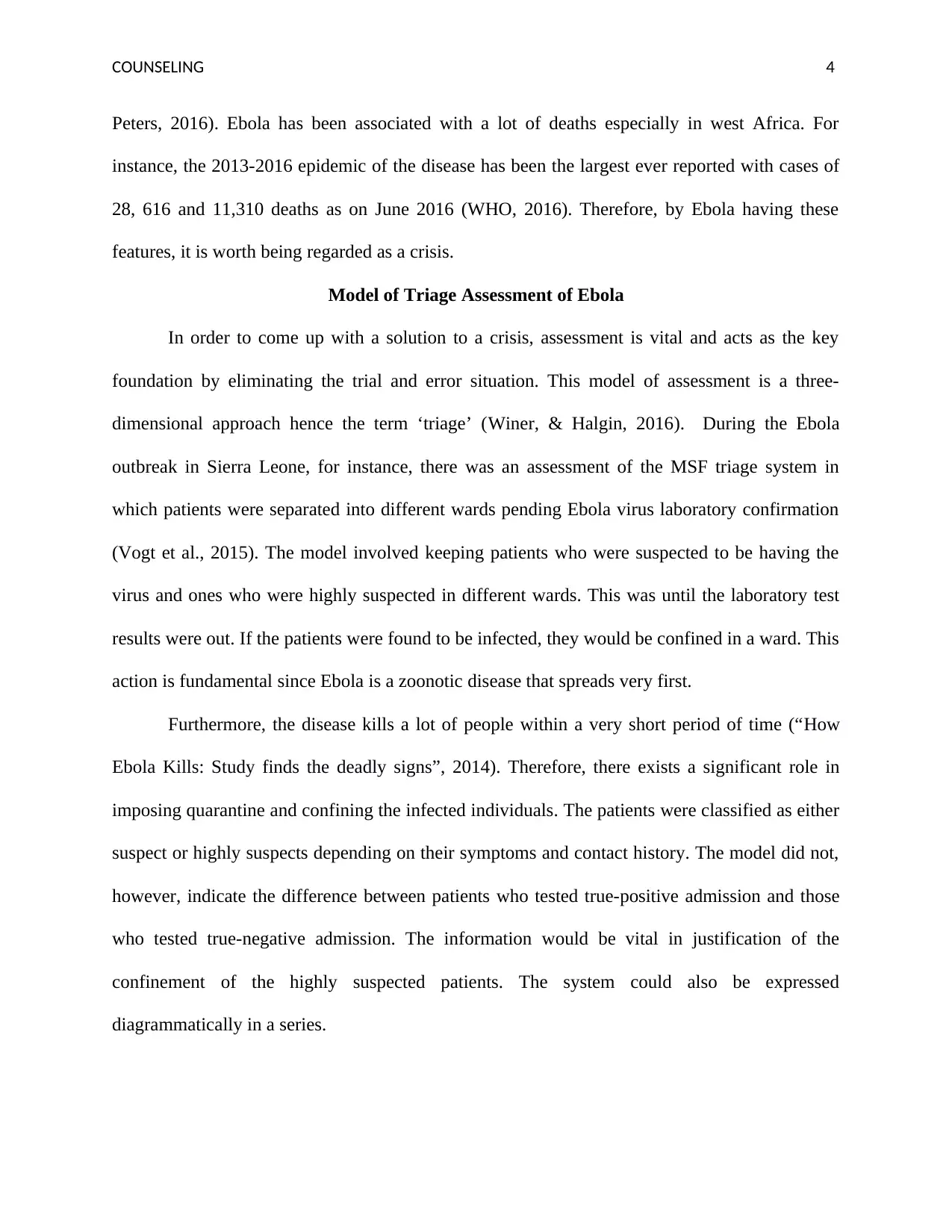
COUNSELING 4
Peters, 2016). Ebola has been associated with a lot of deaths especially in west Africa. For
instance, the 2013-2016 epidemic of the disease has been the largest ever reported with cases of
28, 616 and 11,310 deaths as on June 2016 (WHO, 2016). Therefore, by Ebola having these
features, it is worth being regarded as a crisis.
Model of Triage Assessment of Ebola
In order to come up with a solution to a crisis, assessment is vital and acts as the key
foundation by eliminating the trial and error situation. This model of assessment is a three-
dimensional approach hence the term ‘triage’ (Winer, & Halgin, 2016). During the Ebola
outbreak in Sierra Leone, for instance, there was an assessment of the MSF triage system in
which patients were separated into different wards pending Ebola virus laboratory confirmation
(Vogt et al., 2015). The model involved keeping patients who were suspected to be having the
virus and ones who were highly suspected in different wards. This was until the laboratory test
results were out. If the patients were found to be infected, they would be confined in a ward. This
action is fundamental since Ebola is a zoonotic disease that spreads very first.
Furthermore, the disease kills a lot of people within a very short period of time (“How
Ebola Kills: Study finds the deadly signs”, 2014). Therefore, there exists a significant role in
imposing quarantine and confining the infected individuals. The patients were classified as either
suspect or highly suspects depending on their symptoms and contact history. The model did not,
however, indicate the difference between patients who tested true-positive admission and those
who tested true-negative admission. The information would be vital in justification of the
confinement of the highly suspected patients. The system could also be expressed
diagrammatically in a series.
Peters, 2016). Ebola has been associated with a lot of deaths especially in west Africa. For
instance, the 2013-2016 epidemic of the disease has been the largest ever reported with cases of
28, 616 and 11,310 deaths as on June 2016 (WHO, 2016). Therefore, by Ebola having these
features, it is worth being regarded as a crisis.
Model of Triage Assessment of Ebola
In order to come up with a solution to a crisis, assessment is vital and acts as the key
foundation by eliminating the trial and error situation. This model of assessment is a three-
dimensional approach hence the term ‘triage’ (Winer, & Halgin, 2016). During the Ebola
outbreak in Sierra Leone, for instance, there was an assessment of the MSF triage system in
which patients were separated into different wards pending Ebola virus laboratory confirmation
(Vogt et al., 2015). The model involved keeping patients who were suspected to be having the
virus and ones who were highly suspected in different wards. This was until the laboratory test
results were out. If the patients were found to be infected, they would be confined in a ward. This
action is fundamental since Ebola is a zoonotic disease that spreads very first.
Furthermore, the disease kills a lot of people within a very short period of time (“How
Ebola Kills: Study finds the deadly signs”, 2014). Therefore, there exists a significant role in
imposing quarantine and confining the infected individuals. The patients were classified as either
suspect or highly suspects depending on their symptoms and contact history. The model did not,
however, indicate the difference between patients who tested true-positive admission and those
who tested true-negative admission. The information would be vital in justification of the
confinement of the highly suspected patients. The system could also be expressed
diagrammatically in a series.
Paraphrase This Document
Need a fresh take? Get an instant paraphrase of this document with our AI Paraphraser
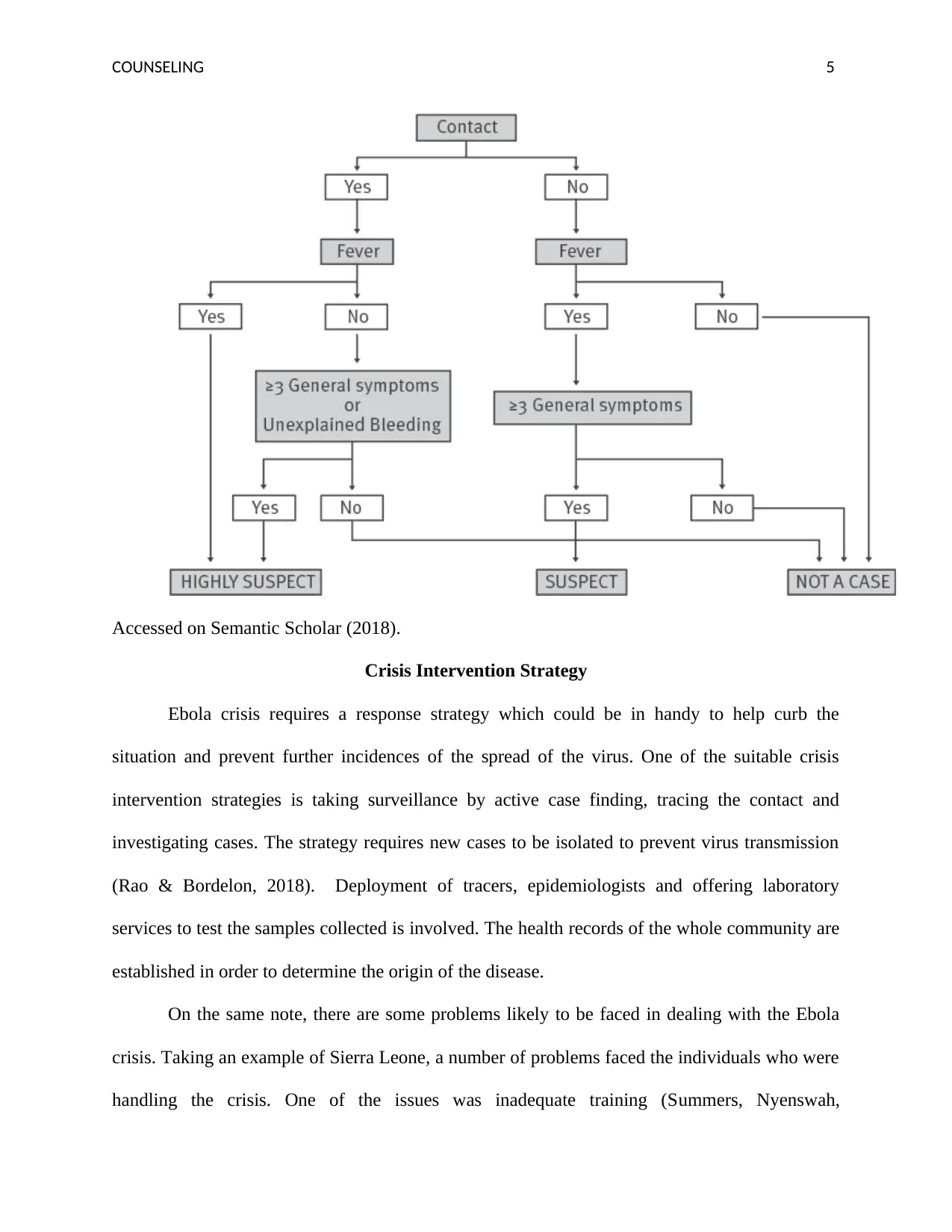
COUNSELING 5
Accessed on Semantic Scholar (2018).
Crisis Intervention Strategy
Ebola crisis requires a response strategy which could be in handy to help curb the
situation and prevent further incidences of the spread of the virus. One of the suitable crisis
intervention strategies is taking surveillance by active case finding, tracing the contact and
investigating cases. The strategy requires new cases to be isolated to prevent virus transmission
(Rao & Bordelon, 2018). Deployment of tracers, epidemiologists and offering laboratory
services to test the samples collected is involved. The health records of the whole community are
established in order to determine the origin of the disease.
On the same note, there are some problems likely to be faced in dealing with the Ebola
crisis. Taking an example of Sierra Leone, a number of problems faced the individuals who were
handling the crisis. One of the issues was inadequate training (Summers, Nyenswah,
Accessed on Semantic Scholar (2018).
Crisis Intervention Strategy
Ebola crisis requires a response strategy which could be in handy to help curb the
situation and prevent further incidences of the spread of the virus. One of the suitable crisis
intervention strategies is taking surveillance by active case finding, tracing the contact and
investigating cases. The strategy requires new cases to be isolated to prevent virus transmission
(Rao & Bordelon, 2018). Deployment of tracers, epidemiologists and offering laboratory
services to test the samples collected is involved. The health records of the whole community are
established in order to determine the origin of the disease.
On the same note, there are some problems likely to be faced in dealing with the Ebola
crisis. Taking an example of Sierra Leone, a number of problems faced the individuals who were
handling the crisis. One of the issues was inadequate training (Summers, Nyenswah,
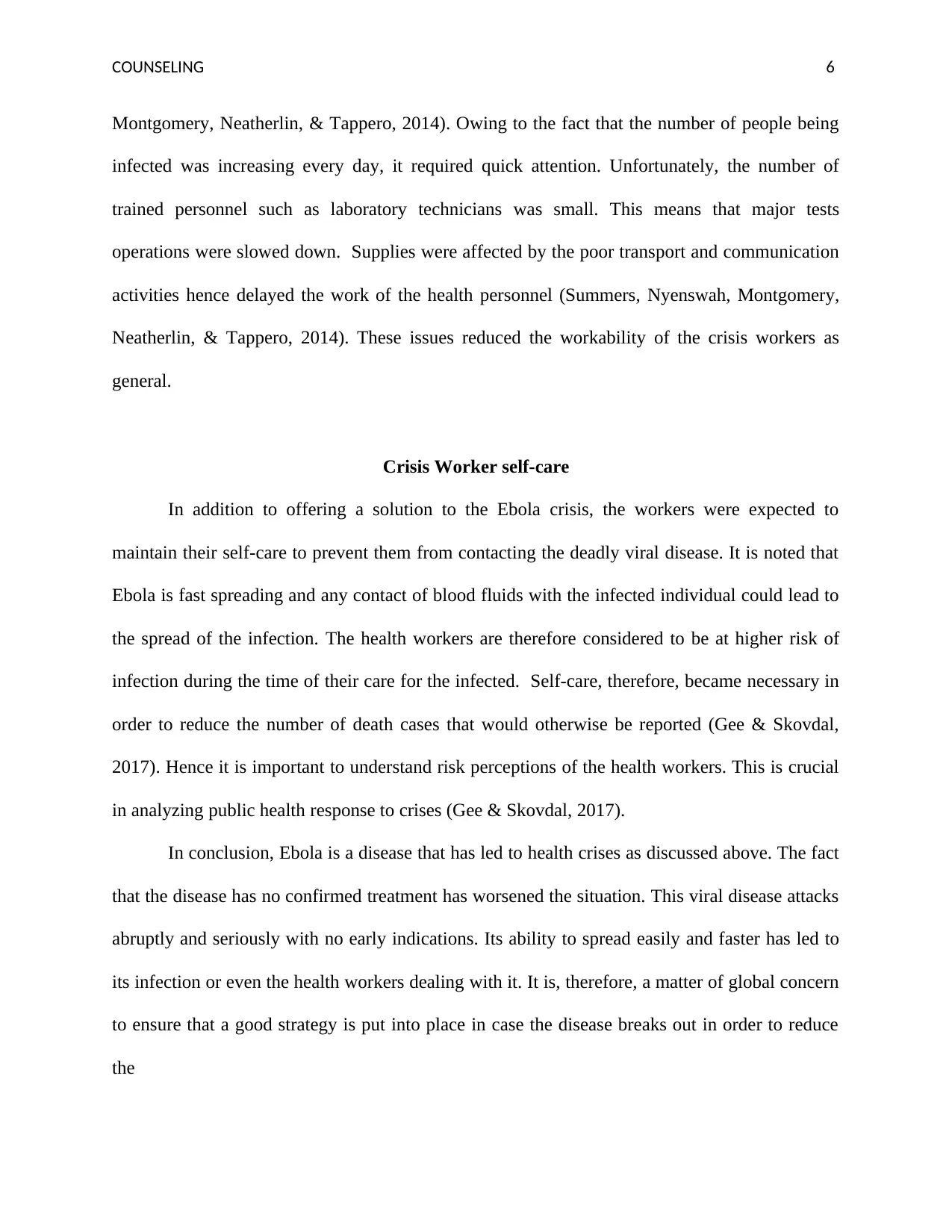
COUNSELING 6
Montgomery, Neatherlin, & Tappero, 2014). Owing to the fact that the number of people being
infected was increasing every day, it required quick attention. Unfortunately, the number of
trained personnel such as laboratory technicians was small. This means that major tests
operations were slowed down. Supplies were affected by the poor transport and communication
activities hence delayed the work of the health personnel (Summers, Nyenswah, Montgomery,
Neatherlin, & Tappero, 2014). These issues reduced the workability of the crisis workers as
general.
Crisis Worker self-care
In addition to offering a solution to the Ebola crisis, the workers were expected to
maintain their self-care to prevent them from contacting the deadly viral disease. It is noted that
Ebola is fast spreading and any contact of blood fluids with the infected individual could lead to
the spread of the infection. The health workers are therefore considered to be at higher risk of
infection during the time of their care for the infected. Self-care, therefore, became necessary in
order to reduce the number of death cases that would otherwise be reported (Gee & Skovdal,
2017). Hence it is important to understand risk perceptions of the health workers. This is crucial
in analyzing public health response to crises (Gee & Skovdal, 2017).
In conclusion, Ebola is a disease that has led to health crises as discussed above. The fact
that the disease has no confirmed treatment has worsened the situation. This viral disease attacks
abruptly and seriously with no early indications. Its ability to spread easily and faster has led to
its infection or even the health workers dealing with it. It is, therefore, a matter of global concern
to ensure that a good strategy is put into place in case the disease breaks out in order to reduce
the
Montgomery, Neatherlin, & Tappero, 2014). Owing to the fact that the number of people being
infected was increasing every day, it required quick attention. Unfortunately, the number of
trained personnel such as laboratory technicians was small. This means that major tests
operations were slowed down. Supplies were affected by the poor transport and communication
activities hence delayed the work of the health personnel (Summers, Nyenswah, Montgomery,
Neatherlin, & Tappero, 2014). These issues reduced the workability of the crisis workers as
general.
Crisis Worker self-care
In addition to offering a solution to the Ebola crisis, the workers were expected to
maintain their self-care to prevent them from contacting the deadly viral disease. It is noted that
Ebola is fast spreading and any contact of blood fluids with the infected individual could lead to
the spread of the infection. The health workers are therefore considered to be at higher risk of
infection during the time of their care for the infected. Self-care, therefore, became necessary in
order to reduce the number of death cases that would otherwise be reported (Gee & Skovdal,
2017). Hence it is important to understand risk perceptions of the health workers. This is crucial
in analyzing public health response to crises (Gee & Skovdal, 2017).
In conclusion, Ebola is a disease that has led to health crises as discussed above. The fact
that the disease has no confirmed treatment has worsened the situation. This viral disease attacks
abruptly and seriously with no early indications. Its ability to spread easily and faster has led to
its infection or even the health workers dealing with it. It is, therefore, a matter of global concern
to ensure that a good strategy is put into place in case the disease breaks out in order to reduce
the
⊘ This is a preview!⊘
Do you want full access?
Subscribe today to unlock all pages.

Trusted by 1+ million students worldwide
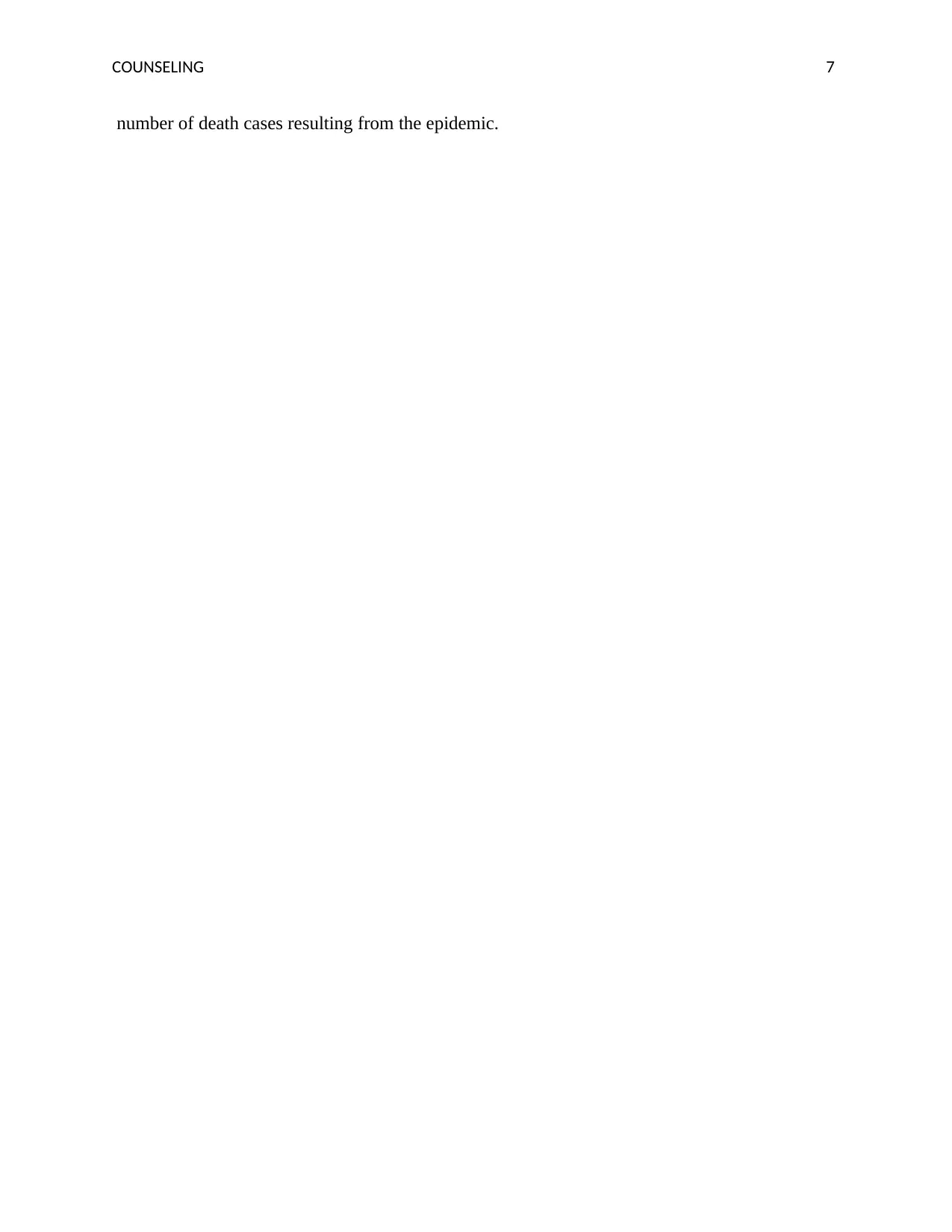
COUNSELING 7
number of death cases resulting from the epidemic.
number of death cases resulting from the epidemic.
Paraphrase This Document
Need a fresh take? Get an instant paraphrase of this document with our AI Paraphraser
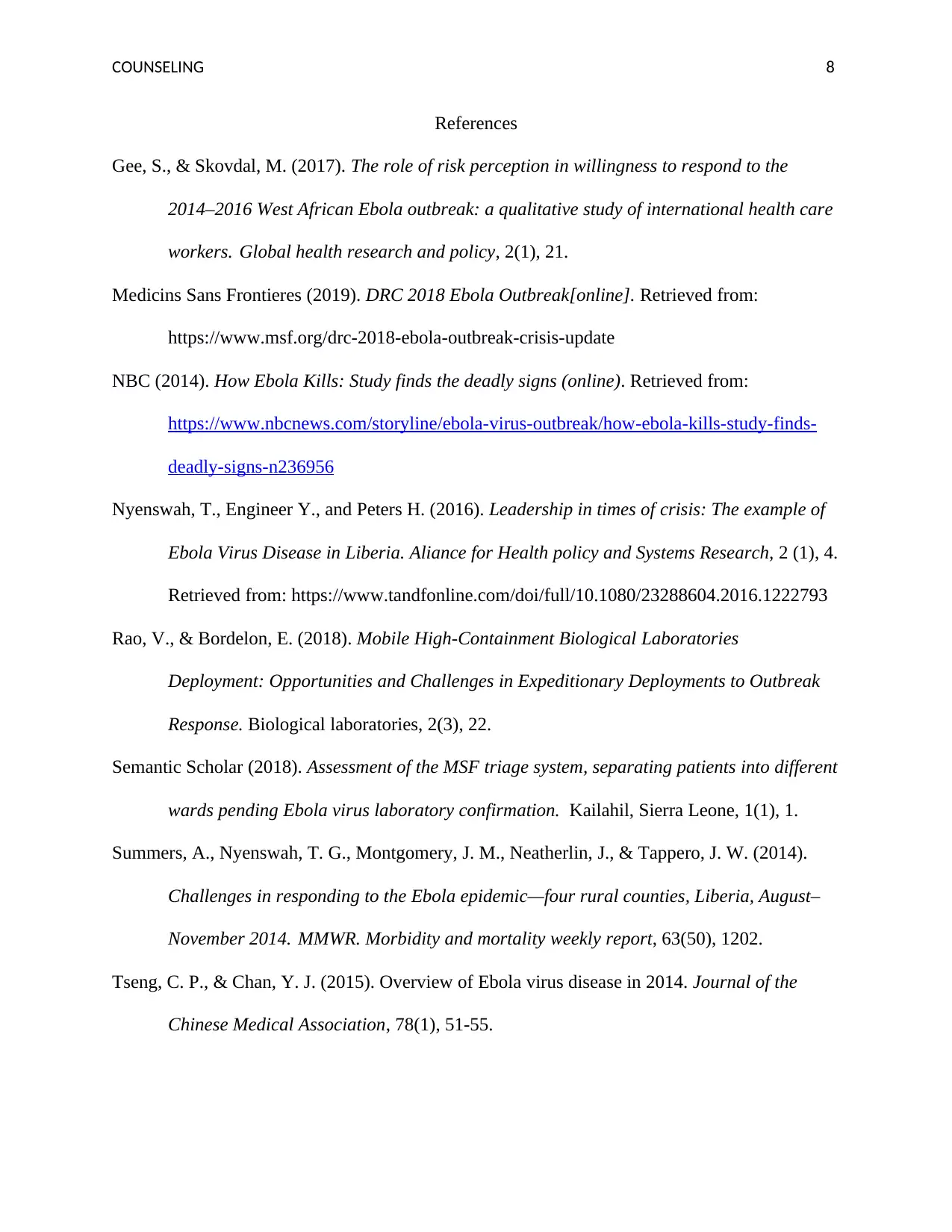
COUNSELING 8
References
Gee, S., & Skovdal, M. (2017). The role of risk perception in willingness to respond to the
2014–2016 West African Ebola outbreak: a qualitative study of international health care
workers. Global health research and policy, 2(1), 21.
Medicins Sans Frontieres (2019). DRC 2018 Ebola Outbreak[online]. Retrieved from:
https://www.msf.org/drc-2018-ebola-outbreak-crisis-update
NBC (2014). How Ebola Kills: Study finds the deadly signs (online). Retrieved from:
https://www.nbcnews.com/storyline/ebola-virus-outbreak/how-ebola-kills-study-finds-
deadly-signs-n236956
Nyenswah, T., Engineer Y., and Peters H. (2016). Leadership in times of crisis: The example of
Ebola Virus Disease in Liberia. Aliance for Health policy and Systems Research, 2 (1), 4.
Retrieved from: https://www.tandfonline.com/doi/full/10.1080/23288604.2016.1222793
Rao, V., & Bordelon, E. (2018). Mobile High-Containment Biological Laboratories
Deployment: Opportunities and Challenges in Expeditionary Deployments to Outbreak
Response. Biological laboratories, 2(3), 22.
Semantic Scholar (2018). Assessment of the MSF triage system, separating patients into different
wards pending Ebola virus laboratory confirmation. Kailahil, Sierra Leone, 1(1), 1.
Summers, A., Nyenswah, T. G., Montgomery, J. M., Neatherlin, J., & Tappero, J. W. (2014).
Challenges in responding to the Ebola epidemic—four rural counties, Liberia, August–
November 2014. MMWR. Morbidity and mortality weekly report, 63(50), 1202.
Tseng, C. P., & Chan, Y. J. (2015). Overview of Ebola virus disease in 2014. Journal of the
Chinese Medical Association, 78(1), 51-55.
References
Gee, S., & Skovdal, M. (2017). The role of risk perception in willingness to respond to the
2014–2016 West African Ebola outbreak: a qualitative study of international health care
workers. Global health research and policy, 2(1), 21.
Medicins Sans Frontieres (2019). DRC 2018 Ebola Outbreak[online]. Retrieved from:
https://www.msf.org/drc-2018-ebola-outbreak-crisis-update
NBC (2014). How Ebola Kills: Study finds the deadly signs (online). Retrieved from:
https://www.nbcnews.com/storyline/ebola-virus-outbreak/how-ebola-kills-study-finds-
deadly-signs-n236956
Nyenswah, T., Engineer Y., and Peters H. (2016). Leadership in times of crisis: The example of
Ebola Virus Disease in Liberia. Aliance for Health policy and Systems Research, 2 (1), 4.
Retrieved from: https://www.tandfonline.com/doi/full/10.1080/23288604.2016.1222793
Rao, V., & Bordelon, E. (2018). Mobile High-Containment Biological Laboratories
Deployment: Opportunities and Challenges in Expeditionary Deployments to Outbreak
Response. Biological laboratories, 2(3), 22.
Semantic Scholar (2018). Assessment of the MSF triage system, separating patients into different
wards pending Ebola virus laboratory confirmation. Kailahil, Sierra Leone, 1(1), 1.
Summers, A., Nyenswah, T. G., Montgomery, J. M., Neatherlin, J., & Tappero, J. W. (2014).
Challenges in responding to the Ebola epidemic—four rural counties, Liberia, August–
November 2014. MMWR. Morbidity and mortality weekly report, 63(50), 1202.
Tseng, C. P., & Chan, Y. J. (2015). Overview of Ebola virus disease in 2014. Journal of the
Chinese Medical Association, 78(1), 51-55.
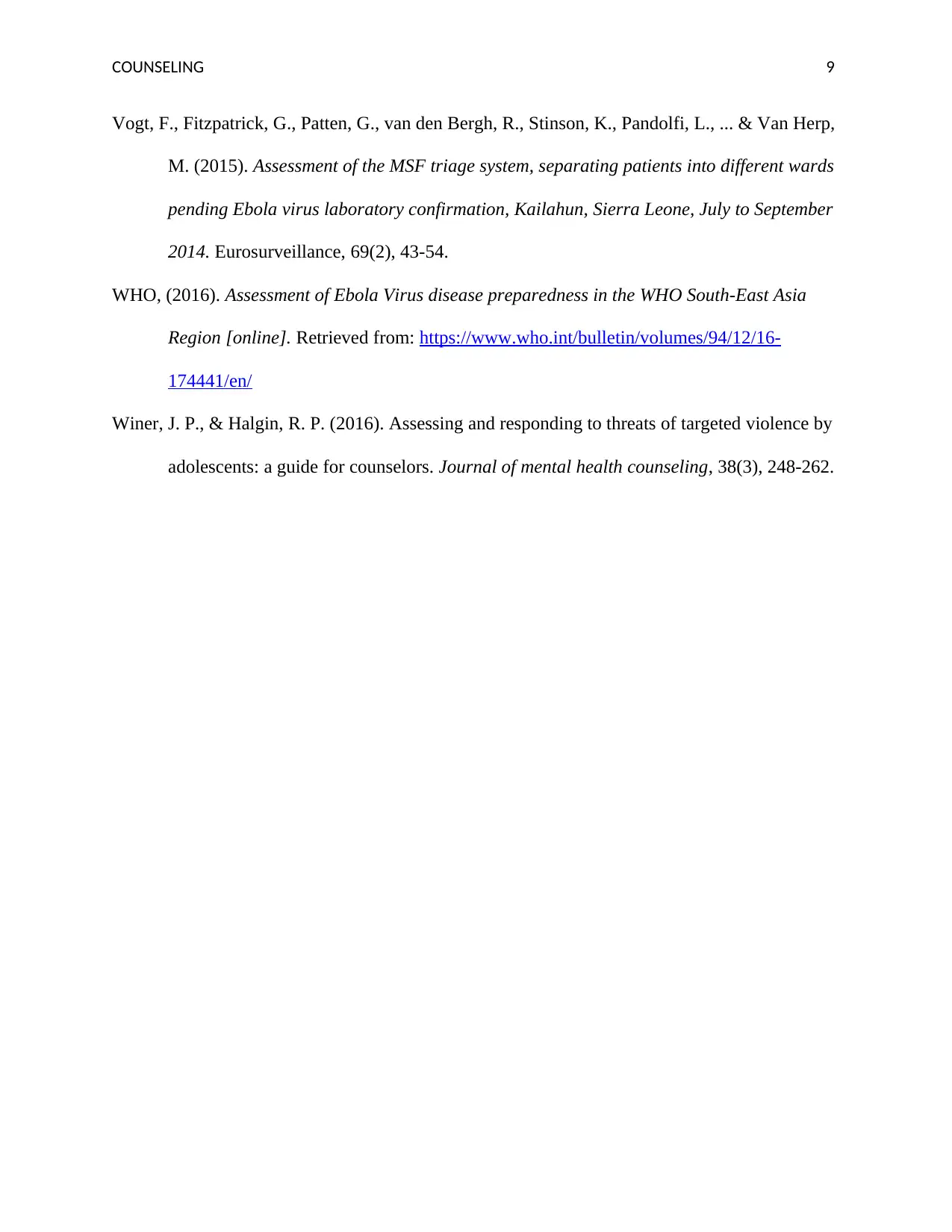
COUNSELING 9
Vogt, F., Fitzpatrick, G., Patten, G., van den Bergh, R., Stinson, K., Pandolfi, L., ... & Van Herp,
M. (2015). Assessment of the MSF triage system, separating patients into different wards
pending Ebola virus laboratory confirmation, Kailahun, Sierra Leone, July to September
2014. Eurosurveillance, 69(2), 43-54.
WHO, (2016). Assessment of Ebola Virus disease preparedness in the WHO South-East Asia
Region [online]. Retrieved from: https://www.who.int/bulletin/volumes/94/12/16-
174441/en/
Winer, J. P., & Halgin, R. P. (2016). Assessing and responding to threats of targeted violence by
adolescents: a guide for counselors. Journal of mental health counseling, 38(3), 248-262.
Vogt, F., Fitzpatrick, G., Patten, G., van den Bergh, R., Stinson, K., Pandolfi, L., ... & Van Herp,
M. (2015). Assessment of the MSF triage system, separating patients into different wards
pending Ebola virus laboratory confirmation, Kailahun, Sierra Leone, July to September
2014. Eurosurveillance, 69(2), 43-54.
WHO, (2016). Assessment of Ebola Virus disease preparedness in the WHO South-East Asia
Region [online]. Retrieved from: https://www.who.int/bulletin/volumes/94/12/16-
174441/en/
Winer, J. P., & Halgin, R. P. (2016). Assessing and responding to threats of targeted violence by
adolescents: a guide for counselors. Journal of mental health counseling, 38(3), 248-262.
⊘ This is a preview!⊘
Do you want full access?
Subscribe today to unlock all pages.

Trusted by 1+ million students worldwide
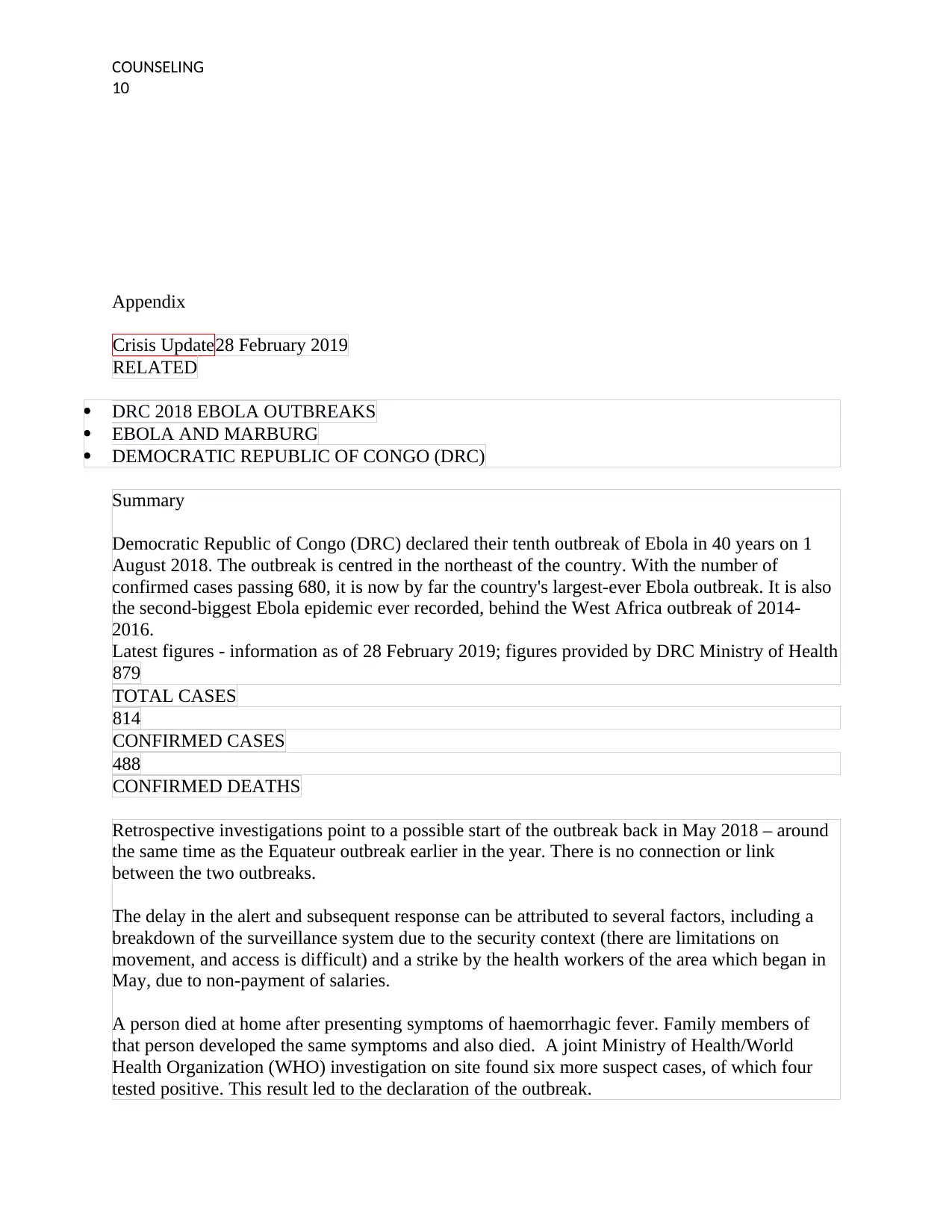
COUNSELING
10
Appendix
Crisis Update28 February 2019
RELATED
DRC 2018 EBOLA OUTBREAKS
EBOLA AND MARBURG
DEMOCRATIC REPUBLIC OF CONGO (DRC)
Summary
Democratic Republic of Congo (DRC) declared their tenth outbreak of Ebola in 40 years on 1
August 2018. The outbreak is centred in the northeast of the country. With the number of
confirmed cases passing 680, it is now by far the country's largest-ever Ebola outbreak. It is also
the second-biggest Ebola epidemic ever recorded, behind the West Africa outbreak of 2014-
2016.
Latest figures - information as of 28 February 2019; figures provided by DRC Ministry of Health
879
TOTAL CASES
814
CONFIRMED CASES
488
CONFIRMED DEATHS
Retrospective investigations point to a possible start of the outbreak back in May 2018 – around
the same time as the Equateur outbreak earlier in the year. There is no connection or link
between the two outbreaks.
The delay in the alert and subsequent response can be attributed to several factors, including a
breakdown of the surveillance system due to the security context (there are limitations on
movement, and access is difficult) and a strike by the health workers of the area which began in
May, due to non-payment of salaries.
A person died at home after presenting symptoms of haemorrhagic fever. Family members of
that person developed the same symptoms and also died. A joint Ministry of Health/World
Health Organization (WHO) investigation on site found six more suspect cases, of which four
tested positive. This result led to the declaration of the outbreak.
10
Appendix
Crisis Update28 February 2019
RELATED
DRC 2018 EBOLA OUTBREAKS
EBOLA AND MARBURG
DEMOCRATIC REPUBLIC OF CONGO (DRC)
Summary
Democratic Republic of Congo (DRC) declared their tenth outbreak of Ebola in 40 years on 1
August 2018. The outbreak is centred in the northeast of the country. With the number of
confirmed cases passing 680, it is now by far the country's largest-ever Ebola outbreak. It is also
the second-biggest Ebola epidemic ever recorded, behind the West Africa outbreak of 2014-
2016.
Latest figures - information as of 28 February 2019; figures provided by DRC Ministry of Health
879
TOTAL CASES
814
CONFIRMED CASES
488
CONFIRMED DEATHS
Retrospective investigations point to a possible start of the outbreak back in May 2018 – around
the same time as the Equateur outbreak earlier in the year. There is no connection or link
between the two outbreaks.
The delay in the alert and subsequent response can be attributed to several factors, including a
breakdown of the surveillance system due to the security context (there are limitations on
movement, and access is difficult) and a strike by the health workers of the area which began in
May, due to non-payment of salaries.
A person died at home after presenting symptoms of haemorrhagic fever. Family members of
that person developed the same symptoms and also died. A joint Ministry of Health/World
Health Organization (WHO) investigation on site found six more suspect cases, of which four
tested positive. This result led to the declaration of the outbreak.
Paraphrase This Document
Need a fresh take? Get an instant paraphrase of this document with our AI Paraphraser
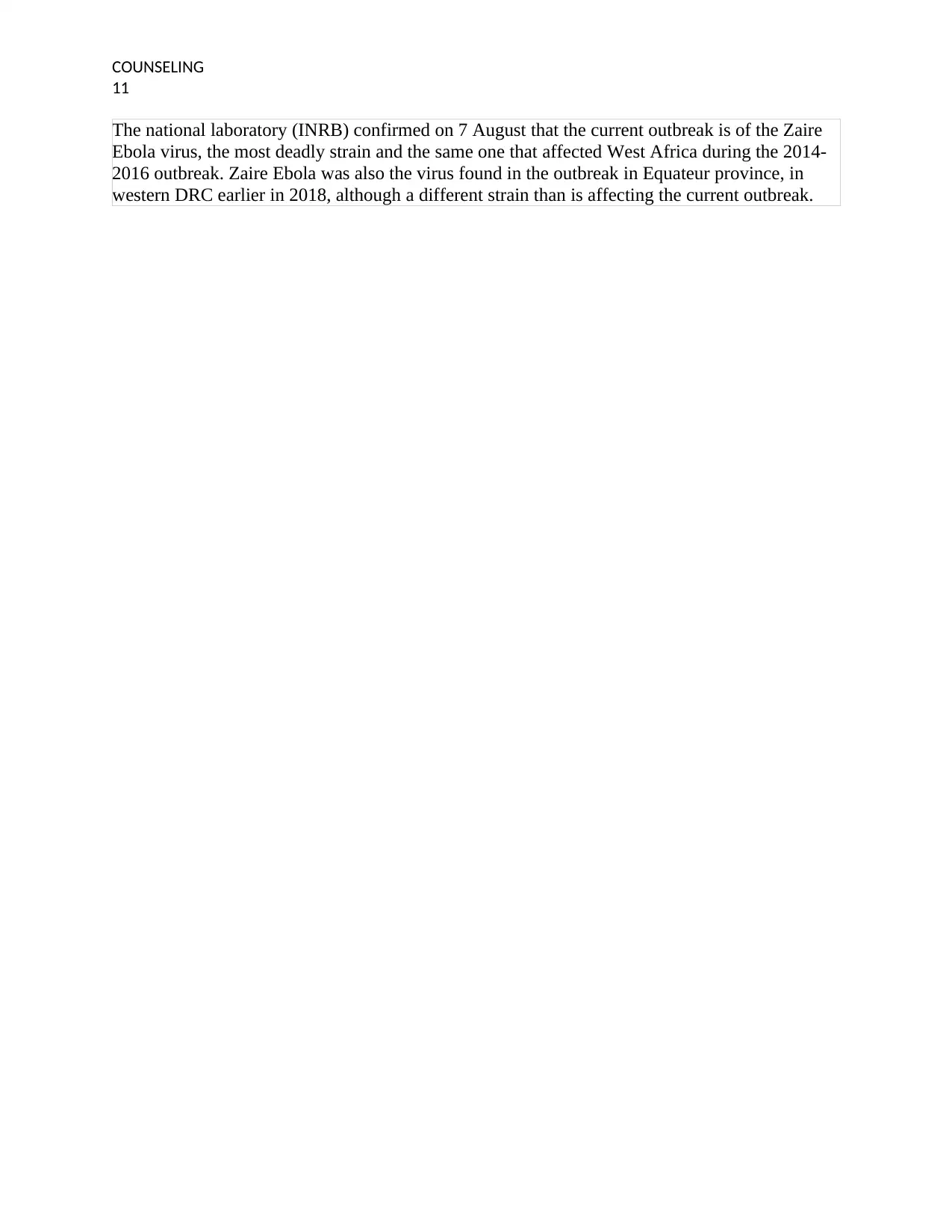
COUNSELING
11
The national laboratory (INRB) confirmed on 7 August that the current outbreak is of the Zaire
Ebola virus, the most deadly strain and the same one that affected West Africa during the 2014-
2016 outbreak. Zaire Ebola was also the virus found in the outbreak in Equateur province, in
western DRC earlier in 2018, although a different strain than is affecting the current outbreak.
11
The national laboratory (INRB) confirmed on 7 August that the current outbreak is of the Zaire
Ebola virus, the most deadly strain and the same one that affected West Africa during the 2014-
2016 outbreak. Zaire Ebola was also the virus found in the outbreak in Equateur province, in
western DRC earlier in 2018, although a different strain than is affecting the current outbreak.
1 out of 11
Related Documents
Your All-in-One AI-Powered Toolkit for Academic Success.
+13062052269
info@desklib.com
Available 24*7 on WhatsApp / Email
![[object Object]](/_next/static/media/star-bottom.7253800d.svg)
Unlock your academic potential
Copyright © 2020–2025 A2Z Services. All Rights Reserved. Developed and managed by ZUCOL.





